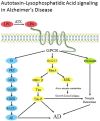Autotaxin⁻Lysophosphatidic Acid Signaling in Alzheimer's Disease
- PMID: 29933579
- PMCID: PMC6073975
- DOI: 10.3390/ijms19071827
Autotaxin⁻Lysophosphatidic Acid Signaling in Alzheimer's Disease
Abstract
The brain contains various forms of lipids that are important for maintaining its structural integrity and regulating various signaling cascades. Autotaxin (ATX) is an ecto-nucleotide pyrophosphatase/phosphodiesterase-2 enzyme that hydrolyzes extracellular lysophospholipids into the lipid mediator lysophosphatidic acid (LPA). LPA is a major bioactive lipid which acts through G protein-coupled receptors (GPCRs) and plays an important role in mediating cellular signaling processes. The majority of synthesized LPA is derived from membrane phospholipids through the action of the secreted enzyme ATX. Both ATX and LPA are highly expressed in the central nervous system. Dysfunctional expression and activity of ATX with associated changes in LPA signaling have recently been implicated in the pathogenesis of Alzheimer's disease (AD). This review focuses on the current understanding of LPA signaling, with emphasis on the importance of the autotaxin⁻lysophosphatidic acid (ATX⁻LPA) pathway and its alterations in AD and a brief note on future therapeutic applications based on ATX⁻LPA signaling.
Keywords: Alzheimer’s disease; GPCR; autotaxin; lysophosphatidic acid.
Conflict of interest statement
The authors declare no conflicts of interest.
Figures

Similar articles
-
Autotaxin, a secreted lysophospholipase D, is essential for blood vessel formation during development.Mol Cell Biol. 2006 Jul;26(13):5015-22. doi: 10.1128/MCB.02419-05. Mol Cell Biol. 2006. PMID: 16782887 Free PMC article.
-
Autotaxin: structure-function and signaling.J Lipid Res. 2014 Jun;55(6):1010-8. doi: 10.1194/jlr.R046391. Epub 2014 Feb 18. J Lipid Res. 2014. PMID: 24548887 Free PMC article. Review.
-
Autotaxin and LPA receptor signaling in cancer.Cancer Metastasis Rev. 2011 Dec;30(3-4):557-65. doi: 10.1007/s10555-011-9319-7. Cancer Metastasis Rev. 2011. PMID: 22002750 Review.
-
Autotaxin-LPA axis regulates hMSC migration by adherent junction disruption and cytoskeletal rearrangement via LPAR1/3-dependent PKC/GSK3β/β-catenin and PKC/Rho GTPase pathways.Stem Cells. 2015 Mar;33(3):819-32. doi: 10.1002/stem.1882. Stem Cells. 2015. PMID: 25376707
-
Autotaxin/Lpar3 signaling regulates Kupffer's vesicle formation and left-right asymmetry in zebrafish.Development. 2012 Dec 1;139(23):4439-48. doi: 10.1242/dev.081745. Epub 2012 Oct 24. Development. 2012. PMID: 23095890
Cited by
-
A Transcriptional Signature of Induced Neurons Differentiates Virologically Suppressed People Living With HIV from People Without HIV.bioRxiv [Preprint]. 2024 Oct 22:2024.10.22.619617. doi: 10.1101/2024.10.22.619617. bioRxiv. 2024. PMID: 39484396 Free PMC article. Preprint.
-
Deregulated Lysophosphatidic Acid Metabolism and Signaling in Liver Cancer.Cancers (Basel). 2019 Oct 23;11(11):1626. doi: 10.3390/cancers11111626. Cancers (Basel). 2019. PMID: 31652837 Free PMC article. Review.
-
Pleotropic Roles of Autotaxin in the Nervous System Present Opportunities for the Development of Novel Therapeutics for Neurological Diseases.Mol Neurobiol. 2020 Jan;57(1):372-392. doi: 10.1007/s12035-019-01719-1. Epub 2019 Jul 30. Mol Neurobiol. 2020. PMID: 31364025 Review.
-
Modulation of Brain Hyperexcitability: Potential New Therapeutic Approaches in Alzheimer's Disease.Int J Mol Sci. 2020 Dec 7;21(23):9318. doi: 10.3390/ijms21239318. Int J Mol Sci. 2020. PMID: 33297460 Free PMC article. Review.
-
Lysophospholipids and Their G-Coupled Protein Signaling in Alzheimer's Disease: From Physiological Performance to Pathological Impairment.Front Mol Neurosci. 2020 Apr 15;13:58. doi: 10.3389/fnmol.2020.00058. eCollection 2020. Front Mol Neurosci. 2020. PMID: 32351364 Free PMC article.
References
-
- Tokumura A., Majima E., Kariya Y., Tominaga K., Kogure K., Yasuda K., Fukuzawa K. Identification of Human Plasma Lysophospholipase D, a Lysophosphatidic Acid-producing Enzyme, as Autotaxin, a Multifunctional Phosphodiesterase. J. Biol. Chem. 2002;277:39436–39442. doi: 10.1074/jbc.M205623200. - DOI - PubMed
Publication types
MeSH terms
Substances
LinkOut - more resources
Full Text Sources
Other Literature Sources
Medical
Miscellaneous

